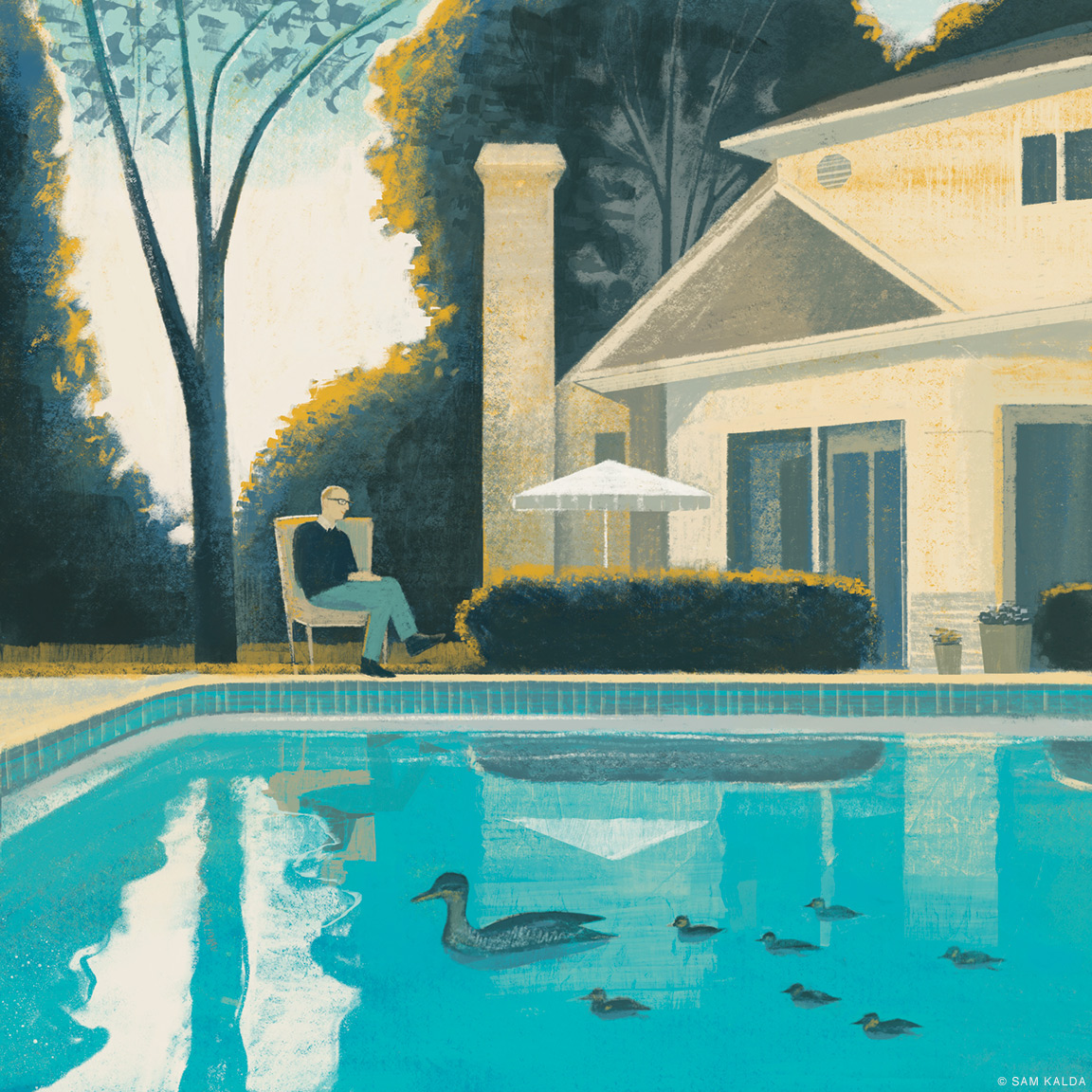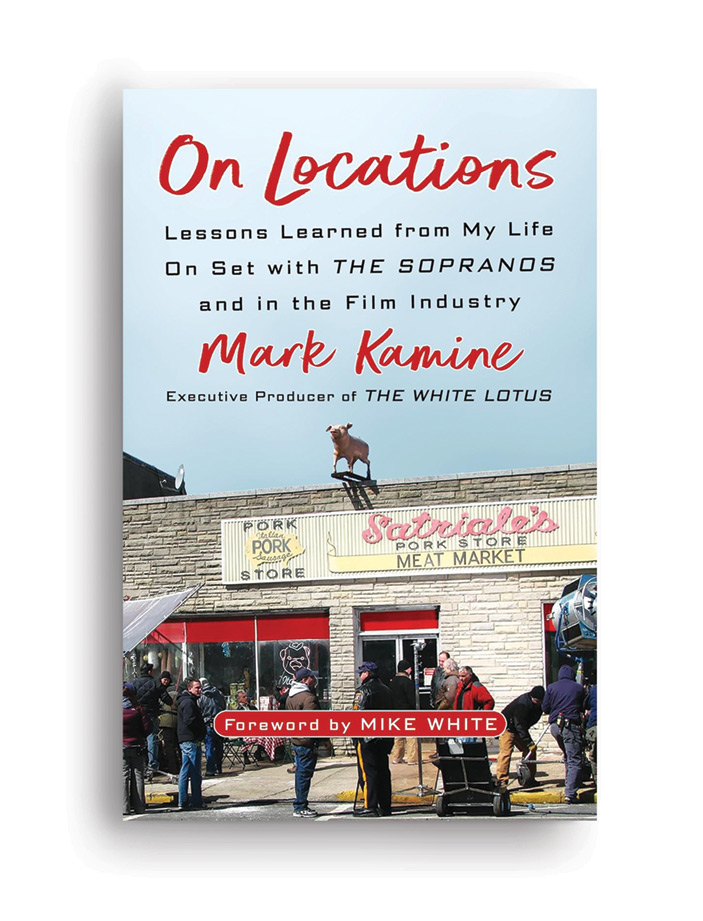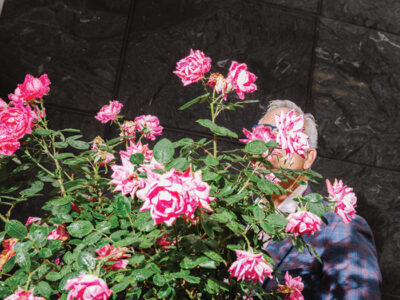
Behind the scenes of The Sopranos and The White Lotus with a veteran television location manager and producer.
When Mark Kamine C’79 was hired for a low-level gig with a show that was “testing well with housewives and professors” on a channel “known for reruns of movies and sporting events,” he didn’t have all that many expectations.

But 25 years after it first aired, The Sopranos remains “the biggest phenomenon of cable TV—really TV as a whole,” says Kamine, who earlier this year published the memoir On Locations: Lessons Learned from My Life On Set with The Sopranos and in the Film Industry to document his experiences behind the scenes of HBO’s famed mobster crime drama.
Serving as the show’s location manager, Kamine was primarily responsible for managing the show’s various settings—from the suburban New Jersey home Tony Soprano shared with his wife and two kids to the strip club and pork store where he and his mobster associates convened.
Since the show’s memorable finale in 2007—which, like the rest of the series that “broke new ground for TV,” bucked expectations—Kamine has worked his way up the film and television ladder, most recently serving as executive producer on another popular HBO series, The White Lotus, which took him from Hawaii (season one) to Italy (season two) and now to Thailand, where “a way bigger” season three is in the works.
Speaking over Zoom from Thailand, where he’s been since November and will remain until June, Kamine admits his good fortune getting to work on two acclaimed series two decades apart. “It’s an unheard-of jackpot to get to do this,” he says.
It’s a far cry, too, from what he thought he’d be doing when he attended Penn in the late ’70s. Though he was a film buff who enjoyed going to local cinemas, “never in a million years would have it occurred to me to work on movies,” he says. Instead, he zeroed in on a writing career, majoring in English, studying under the likes of Mexican novelist Carlos Fuentes, and winning a playwriting award. After graduating from Penn, with guidance from professor Robert Storey, he pursued a master’s in English at UCLA, where he had “some encounters with the film business, just by coincidence.”
A New Jersey native, Kamine moved back across the country to live in New York City but veered off course when he decided to go to law school at Rutgers. He lasted one semester. “My father was a lawyer,” he says. “I guess I finally got it out of my system, the idea of trying to do something like him.” The first chapter of On Locations touches upon battles with anxiety he and his dad both waged, the “severest period” hitting Kamine in his early twenties when he dropped out of law school. “That ejected me out the other side and into the clouds for a few years, figuring out where I wanted to go.”
The rise of independent films in the ’80s—and his continued passion for them—set him down a new path. After doing a variety of jobs in New York—from copy editing and freelance writing to working in an art gallery and as a carpenter’s assistant—Kamine enrolled at NYU Tisch School of the Arts, where he got an MFA degree in film. He then spent most of the ’90s in the underbelly of the industry, starting off as a location scout and driving around New York and New Jersey to find the best places for scenes, sometimes slipping cash to building supers to grease the skids toward setting up a shoot (as was “pretty constant in the film world” at the time). It was hardly glamorous work. “I spent a good amount of time setting up catering and craft service tables and cleaning and mopping and getting called to set to chase away a pigeon that was dying,” he says.
Though it was far from lucrative, Kamine made enough contacts in the production world to land on The Sopranos by the end of the decade. For that series, he had a team of location scouts working with him, but Kamine proudly takes credit for spotting what would become Satriale’s Pork Store. “Driving along the main drag in Kearny, New Jersey, I spot an empty storefront near the central shopping district whose situation at the bottom of an inverted T provides good exterior angles and enough of a downtown feel to make sense as a retail venue,” he wrote in On Locations, adding that Sopranos creator David Chase liked the location, so Kamine made a deal with the property owner, who had recently bought the building for his office-cleaning company. “I tell him to stop construction and we’ll pay his rent somewhere else along with a decent fee for the building.” Soon enough, fictional meetings and mob hits were happening there over slices of gabagool.
Other chapters of the book detail Kamine’s working relationship with the mercurial Chase and the erratic behavior of the late megastar James Gandolfini. He also wrote about the sometimes-challenging dealings with the real-life owners of the house where Tony Soprano lived and the strip club where he worked. And he provided firsthand accounts of some of the show’s most lauded episodes, including “College,” in which Kamine took on a minor acting role, and “Pine Barrens,” in which main characters Christopher and Paulie Walnuts famously get lost in the snow-covered woods chasing a Russian nemesis. Interestingly, the crew “had to scramble to find another wooded area” when a Jersey politician who didn’t like the show’s portrayal of Italian Americans quashed the original Essex County location. That politician, Kamine wrote, ended up going to prison on corruption charges.
“I love reading books about film and TV, and also novels and stories set in Hollywood,” Kamine says. “But most of them are told, for good reason, from the point of view of actors and maybe directors. … I started very low in the ranks of film production, and I wanted to show that perspective.”
Kamine was better suited than most to write a book. Throughout his time working in TV production, he maintained a steady gig penning book reviews, primarily for the London-based Times Literary Supplement. He initially thought that could lead to a career in screenwriting—and once wrote a Sopranos spec script—but realized his “more natural arena was a literary one.”
Kamine says he managed to keep his “very different worlds” separate while on The Sopranos, but White Lotus creator Mike White took notice when he googled Kamine and found “a bunch of inarguably well-written book reviews,” White wrote in a foreword to On Locations. “A line producer who is also an astute reader of literature—and a great writer himself? This can’t be the same Mark Kamine. But it was. I haven’t worked with another line producer since.” White went on to praise Kamine’s “humanist outlook, born of a writerly mind” as being crucial to the show.
For Kamine, The White Lotus marks what could be the final chapter. After The Sopranos, Kamine did three movies with director David O. Russell—The Fighter, American Hustle, and Silver Linings Playbook, the latter of which was a “particular pleasure” since it brought him back to Philly “all those years after my Penn days.” He also worked on a movie called Brad’s Status with White, who early in the pandemic was hired by HBO to create a COVID-friendly show shot primarily in one location. White called up his old colleague and “the next thing we knew we are at the 400-room Four Seasons Maui hotel,” says Kamine, who, along with his wife Tana, White, and producer David Bernad, had the run of the empty resort while prepping the first season of The White Lotus.
Despite plenty of production hiccups and COVID scares along the way—“That’s maybe for another book,” Kamine says—the show became an instant hit and won an Emmy for Outstanding Limited or Anthology Series, spawning the idea for more seasons with different characters in different exotic locales.
“It’s been a similar experience to [The Sopranos] of this sudden boom,” he says. “I feel so privileged to do this. And I might just run my career out on this show.” —DZ




